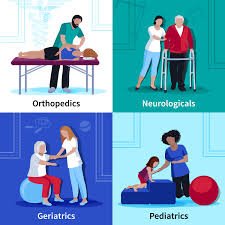What is physiotherapy??
Physiotherapy or physical therapy is a health care profession.
Helps to restore loss of movement and function , when someone is affected by illness, injury and disability.
Aims to reduce all forms of pain and physical dysfunction .
Also aims to reduce the possibility of pain or injury becoming deep, rooted and severe .

Criteria to apply forPhysiotherapy
- 10 + 12th
- science stream student
How long it take to become a Physiotherapy
The course of physiotherapy includes four years and six months . In which six months includes internship and four years of physiotherapy study.
And for Specialised Physiotherapist , there are masters in physiotherapy for two year course .
What are the subjects in Physiotherapy?
The subjects of physiotherapy depend upon the semester, but here is some of the subject which is mentioned below
- Anatomy
- Physiology
- Microbiology
- Pharmacology
- Sociology
- Psychology
- Biomechanics
- Electro therapy
- Pathology
- first aid and basic nursing
- Orientation to physiotherapy
- Cardio respiratory physiotherapy
- Neurological physiotherapy
- General surgery
- Geriatric physiotherapy
- Evidence based physiotherapy
- Research methodology and biostats
- Exercise therapy
- Community medicine
- Community based rehabilitation CBR
Masters courses in Physiotherapy.
- Physiotherapy in ortho
- Physiotherapy in Neuro
- Physiotherapy in cardio-respiratory
- Physiotherapy in musculoskeletal
- Physiotherapy in sports
- Physiotherapy in Paediatrics
ROLE
- Reduces pain.
- Increase muscle strength.
- Increases muscle endurance.
- Regain loss of movement.
- Prevents re occurrence of symptoms in later stage.
WHEN TO CONSULT A PHYSIOTHERAPIST?
- Re occurring Pain over any area of muscle, or joint pain
- Experiencing continuous pain while standing, sitting, or lifting heavy weights.
- Muscle weakness
- Injury. ( like sports injuries)
- Mobility issues
- Neurological disorders ( like stroke, child palasy ,
- If there is no other option to surgery
- Lack of balance
- Post surgery
- After surgery
- During pregnancy
¥ Mode of treatment/ How they treats a patient?
There are two mode of treatment of a physiotherapy
A Manual by hand
B Electrical modalities
C Patient education
A ~ MANUAL
(by hands )
1 Physical exercises( stretching exercises, strengthening exercises , breathing exercises etc)
2 Manual therapy
3 Massage therapy
4 Manipulation techniques
5 tapping
6 AISTM
7 Manual Traction
B ~ ELECTRICAL MODALITIES
Hot and cold therapy equipment
Laser
SWD
TENSE
SHOCK WAVE
Ultrasound
UV rays
Electrical muscle stimulator
Electrical cervical traction
Electrical lumbar traction
C ~ PATIENT EDUCATION
It is very important to educate a patient about their condition.
So according to condition, what activities patient have to avoid and what activities that patient have to do. i.e. do’s and don’ts, because all the time the physiotherapist is not available, so patient have to take care by themselves .
For example, avoid heavy weight lifting, avoid stair climbing ,Avoid forward bending
And educate patient how to bend forward, how to lift a weight , how climb a stair etc.
FAQ
Goals ?
Physiotherapy goals are customised based on the disease, age, and general health of each patient to fulfil their unique needs.Common physiotherapy goals include:
1. Pain Relief: Alleviate acute or chronic pain through various therapeutic techniques.
2. Mobility Improvement: Enhance the range of motion in joints and flexibility in muscles.
3. Strength Enhancement: Increase muscle strength to support overall body function and prevent injury.
4. Functional Independence: Enable patients to perform daily activities independently and safely.
5. Posture Correction: Improve body alignment to prevent pain and injury.
6. Balance and Coordination: Enhance balance and coordination to prevent falls, especially in elderly patients.
7. Recovery from Injury or Surgery: Facilitate the healing process and restore function after injuries or surgical procedures.
8. Chronic Disease Management: help with the management of symptoms and enhancement of life for ailments including diabetes, COPD, or arthritis.
9. Prevention of Re-injury: Educate patients on proper techniques and exercises to avoid future injuries.
10. Sports Performance Optimisation: Improve athletic performance and prevent sports-related injuries.
Exercises, manual therapy, teaching, and the application of modalities like heat, ice, or electrical stimulation are some of the ways that these objectives are met.
